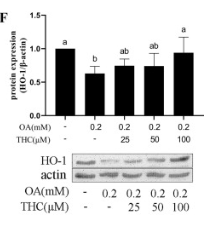HO-1 Antibody - #DF6391
| Product: | HO-1 Antibody |
| Catalog: | DF6391 |
| Description: | Rabbit polyclonal antibody to HO-1 |
| Application: | WB IHC |
| Cited expt.: | WB |
| Reactivity: | Human, Mouse, Rat |
| Mol.Wt.: | 33kDa; 33kD(Calculated). |
| Uniprot: | P09601 |
| RRID: | AB_2838354 |
Product Info
*The optimal dilutions should be determined by the end user. For optimal experimental results, antibody reuse is not recommended.
*Tips:
WB: For western blot detection of denatured protein samples. IHC: For immunohistochemical detection of paraffin sections (IHC-p) or frozen sections (IHC-f) of tissue samples. IF/ICC: For immunofluorescence detection of cell samples. ELISA(peptide): For ELISA detection of antigenic peptide.
Cite Format: Affinity Biosciences Cat# DF6391, RRID:AB_2838354.
Fold/Unfold
32 kD; bK286B10; D8Wsu38e; heat shock protein 32 kD; heat shock protein 32kD; Heat shock protein; Heme oxygenase (decycling) 1; Heme oxygenase 1; Hemox; HMOX 1; Hmox; Hmox1; HMOX1_HUMAN; HO 1; HO; HO-1; HO1; Hsp32;
Immunogens
A synthesized peptide derived from human HMOX1, corresponding to a region within the internal amino acids.
Expressed at higher levels in renal cancer tissue than in normal tissue (at protein level).
- P09601 HMOX1_HUMAN:
- Protein BLAST With
- NCBI/
- ExPASy/
- Uniprot
MERPQPDSMPQDLSEALKEATKEVHTQAENAEFMRNFQKGQVTRDGFKLVMASLYHIYVALEEEIERNKESPVFAPVYFPEELHRKAALEQDLAFWYGPRWQEVIPYTPAMQRYVKRLHEVGRTEPELLVAHAYTRYLGDLSGGQVLKKIAQKALDLPSSGEGLAFFTFPNIASATKFKQLYRSRMNSLEMTPAVRQRVIEEAKTAFLLNIQLFEELQELLTHDTKDQSPSRAPGLRQRASNKVQDSAPVETPRGKPPLNTRSQAPLLRWVLTLSFLVATVAVGLYAM
Research Backgrounds
Heme oxygenase cleaves the heme ring at the alpha methene bridge to form biliverdin. Biliverdin is subsequently converted to bilirubin by biliverdin reductase. Under physiological conditions, the activity of heme oxygenase is highest in the spleen, where senescent erythrocytes are sequestrated and destroyed. Exhibits cytoprotective effects since excess of free heme sensitizes cells to undergo apoptosis.
Microsome. Endoplasmic reticulum membrane>Peripheral membrane protein>Cytoplasmic side.
Expressed at higher levels in renal cancer tissue than in normal tissue (at protein level).
Belongs to the heme oxygenase family.
Research Fields
· Cellular Processes > Cell growth and death > Ferroptosis. (View pathway)
· Environmental Information Processing > Signal transduction > HIF-1 signaling pathway. (View pathway)
· Human Diseases > Cancers: Overview > Pathways in cancer. (View pathway)
· Human Diseases > Cancers: Overview > MicroRNAs in cancer.
· Human Diseases > Cancers: Specific types > Hepatocellular carcinoma. (View pathway)
· Metabolism > Metabolism of cofactors and vitamins > Porphyrin and chlorophyll metabolism.
· Metabolism > Global and overview maps > Metabolic pathways.
· Organismal Systems > Digestive system > Mineral absorption.
References
Application: WB Species: Human Sample: HepG2 cells
Restrictive clause
Affinity Biosciences tests all products strictly. Citations are provided as a resource for additional applications that have not been validated by Affinity Biosciences. Please choose the appropriate format for each application and consult Materials and Methods sections for additional details about the use of any product in these publications.
For Research Use Only.
Not for use in diagnostic or therapeutic procedures. Not for resale. Not for distribution without written consent. Affinity Biosciences will not be held responsible for patent infringement or other violations that may occur with the use of our products. Affinity Biosciences, Affinity Biosciences Logo and all other trademarks are the property of Affinity Biosciences LTD.
